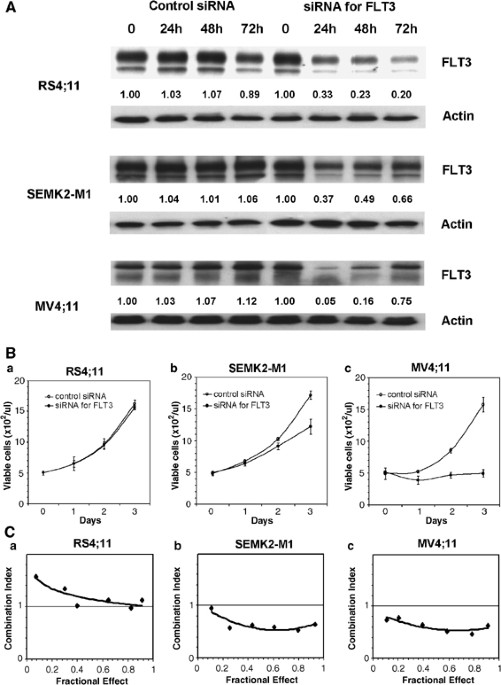
Human leukemias with mutated FLT3 kinase are synergistically sensitive to FLT3 and Hsp90 inhibitors: the key role of the STAT5 signal transduction pathway
- Select a language for the TTS:
- UK English Female
- UK English Male
- US English Female
- US English Male
- Australian Female
- Australian Male
- Language selected: (auto detect) - EN
Play all audios:
17-allylamino-17-demethoxygeldanamycin (17-AAG), an inhibitor of the molecular chaperone heat shock protein 90, results in cell type-specific inhibition of proliferation of leukemic cells.
GTP14564 is a tyrosine kinase inhibitor actively against FLT3. The current study evaluated the single and combined effects of 17-AAG and GTP14564, and the role of FLT3 in their inhibitory
effects. The importance of FLT3 mutations was demonstrated using small interfering RNA (siRNA) targeted to FLT3. Similar to FLT3 siRNA, GTP14564 inhibited FLT3 internal tandem duplication
(ITD) cells (MV4;11) and FLT3 amplified wild-type cells (SEMK2-M1), but not wild-type FLT3 cells (RS4;11). However, when RS4;11 cells were stimulated with FLT3-ligand, phosphorylation of
STAT5 and GTP14564 inhibition were observed. Responses to GTP14564 in all cell types were directly related to the level of STAT5 phosphorylation in the cells. We observed synergistic effects
of combined 17-AAG and GTP14564 in cell lines with FLT3-ITD and amplified wild-type FLT3. Combined treatment with 17-AAG and GTP14564 reduced the levels of p-FLT3 and p-STAT5, enhanced
G0/G1 arrest and apoptosis in FLT3-ITD and amplified wild-type FLT3. The combination of 17-AAG with FLT3 kinase inhibitors can enhance targeted therapy in leukemias with FLT3 mutations, such
as MLL fusion gene leukemias.
Supported in part from a grant from the National Cancer Institute (CA087053) to JK and the Childrens Cancer Research Fund to JK.
Present address: Kochi Health Sciences Center, 2125-1 IKE, Kochi, 780-8555, Japan
The Cancer Center, University of Minnesota, Minneapolis, MN, USA
The Division of Cellular Therapy, Institute of Medical Science, University of Tokyo, Tokyo, Japan
Anyone you share the following link with will be able to read this content: